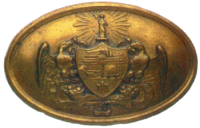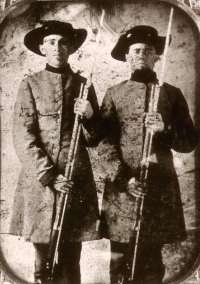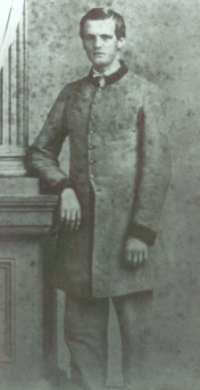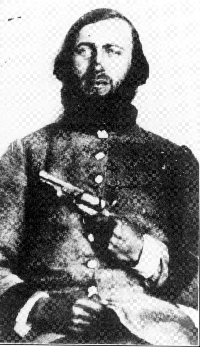 |
 |
 |
 |
Arkansas was poorly prepared
to raise and equip an army of its own in the early spring and
summer of 1861. While the General Assembly had provided for a
State Militia, this was a loose grouping of individual companies,
each responsible for its own selection and procurement of uniforms
and weaponry, and a small administrative staff at the state level.
Thus Arkansas was even more ill-prepared to clothe and equip an army when secession became a fact in the first week of May, 1861. Nearly completely a rural state and wholly dependent on agriculture, Arkansas's only clothing manufactory was at Nashville, in the southwestern corner of the state. Virtually all of the clothing supplied to the first companies to answer the call to arms was improvised, and mostly homemade, or consisted of the militia uniforms unique to each company.
On May 15, 1861 the Secession Convention, acting in a legislative capacity for the new Confederate state, created the Army of Arkansas and established the Arkansas Military Board to serve as a sort of war department for the state. Consisting of the Governor as chair, and two appointed board members, the Military Board had the power to mobilize the State Troops and volunteer forces, to launch military expeditions as needed to defend the state, and to manage and control the forts, arms, and munitions of the state as an auxiliary to the Confederate authority. The Convention appropriated two million dollars to the Board for its operations.
While most of the historical interest in the activities of the Military Board have focused on the political maneuverings of its members and the general officers appointed to the State Troops, the Board also took measures to establish manufactories for military arms and supplies for the troops. Armaments came primarily from weapons seized from U.S. Army arsenals at Little Rock, Fort Smith, Pine Bluff, and Napoleon. Repair shops were established at the Little Rock arsenal and at Hopefield (present day West Memphis) to convert these weapons, primarily flintlocks, to percussion ignition and to attempt to repair the large number of "junker" weapons from the arsenals as well as others purchased or collected from private sources.
As the Arkansas troops were transferred to Confederate service, the central government in Richmond began providing funds to or reimbursing the states for their expenses in arming and clothing the troops. During the first year and a half of the War, the Confederate government did not furnish uniforms to the troops upon their entering the service, but paid them or provided funds to their state for their uniforms and equipment. This was known as the "commutation" system, and in Arkansas, the Military Board took these funds and used them to establish a clothing and equipment manufactory at the Arkansas State Penitentiary in Little Rock.
Arkansas had joined a number of other states in the early 1840s in establishing penitentiaries in the belief that criminals could be reformed and returned to society. The Arkansas State Penitentiary was located in a set of buildings atop a hill just outside the western edge of the city. Operated by contractors, the State Pen offered inmates vocational training in wagon-making, carpentry, and tailoring. With approximately a hundred inmates incarcerated in 1860, the penitentiary offered the Military Board an ideal, captive labor force with the needed skills to clothe and equip a state army.
Patterning its uniform after the pre-war uniform of the U.S. Army, the Military Board established a frock coat, trousers, and a forage cap, all made of gray woolen jeans material, as its basic ensemble. A.J. Ward, the penitentiary's superintendent, reported to the state legislature on November 18, 1861 that by that time the penitentiary shops had completed 3,000 sets of uniform, 8,000 pairs of shoes, 250 wagons, 100 sets of wagon and artillery harness, 500 drums, 200 tents, 600 knapsacks, and 500 cartridge boxes for the Arkansas regiments.
Issuance of the uniforms seems to have gone first to the regiments sent to the "seat of the War" in Virginia and the Mississippi River. Fagan's 1st Arkansas reported getting a new issue of uniforms while in camp around Fredericksburg, VA, and the regiments in the Mississippi valley were likewise issued uniforms in the early fall of 1861.
The clothing records of many of the Arkansas units serving in the Mississippi Valley show that they received an issue of new uniforms from the State between October and December of 1861, and it is likely that this is the style of the state "commutation" uniform thus issued. Phillip Dangerfield Stephenson of St. Louis, MO described the uniform he was issued upon his enlistment in Co. K, 13th Arkansas Infantry near Belmont, Missouri, in mid-September, 1861:
"I was about the last recruit for the regiment, at least for a season. When they fitted me out in soldier clothes, it was rare work. All the uniform shoes, hats, etc., had been picked over and only odds and ends were left. Lieutenant Bartlett roared as I tried on one thing after another. I finally emerged - and was a sight! I had on a long frock coat of coarse brown cloth, butternut color, very tight, buttoned up to the chin on my long rail-like body. My pants, of the same stuff, were a mile too big, baggy as sacks, legs rolled up at the bottom. Our uniforms were mostly the same dirt color, the coats having brass buttons and black cuffs and collars. My hat, a common light colored wool, was passable to fit, but my shoes, coarse brogans, were a No. 9 and a No. 8! I laughed it off and was proud of being in uniform."
Clothing records of the 34th Arkansas Infantry of Hindman's 1st Corps, Army of the Trans-Mississippi, show the issuance of a quantity of "coats", jackets, and caps in November 1862, and these items appear to have been from the Military Board's stocks.
Tintypes and ambrotypes of Arkansas soldiers taken during late 1862 and especially in the first half of 1862 frequently depict these frock coats. One of the most widely known features brothers James May of the 22nd Arkansas Infantry and George May of the 2nd Arkansas Mounted Rifles.
Private L. Yates of Company B, 18th Arkansas Infantry had his image taken in one of these jackets during the late spring or early summer of 1862. Private Yates enlisted in the 18th Arkansas on March 12, 1862, and fought with the regiment during the Corinth, Mississippi Campaign the following fall, and surrendered at Port Hudson in July, 1863.
The photograph of Yates gives us a lot more details about this uniform. It is a single-breasted frock coat of gray jean-wool, with an 8-button closure. The collar and cuff trim is a medium to dark blue, and the cuff trim are cut in a straight line rather than the pointed fashion seen on most reproduction coats.
McCulloch's troops in northwest Arkansas, which became part of Van Dorn's "Army of the West" received uniforms before the Pea Ridge Campaign early in 1862, and finally Hindman's troops in the 1st Corps, Army of Trans-Mississippi were issued new uniforms in November, 1862 just before setting off on the campaign which led to the battle of Prairie Grove. This basic style of uniform remained in use at least through the summer of 1863; when Little Rock fell to General Frederick Steele's Arkansas Expedition, and Confederate quartermaster and ordnance operations in Little Rock ceased and moved to southwest Arkansas and Texas.
 |
  |
 |
AN ADDITIONAL WINDFALL in our ongoing research into what Arkansas
Confederates really wore came from John
Schwarz of the Dixie Guard. This came in the form of nearly twenty
photographs of a surviving frock coat presumed to have been made
by the Little Rock Arsenal in late 1862 or early 1863.
This garment is in a private collection
in Minnesota, and is believed to be an enlisted issue product
from the Little Rock Penitentary, circa. 1863. The owner reports
that the coat was brought home by a sergeant from the 3rd Minnesota
Infantry Regiment, which was the first federal unit to enter Little
Rock upon its fall on September 10, 1863.
The coat was found several years ago with a large number of items from the estate of Captain Otto F. Dreher. Captain Dreher was the last commander of Company A, 3rd Minnesota Volunteer Infantry. He died in 1889. During the Little Rock Campaign in the summer of 1863, Dreher was a lieutenant in Company A. The 3rd Minnesota was the first Federal infantry unit to enter Little Rock, crossing the Arkansas River on a pontoon bridge thrown across near the present-day location of the Main Street Bridge.
The owner notes that the buttons are unmarked (possibly Confederate copies of the) brass enlisted eagle general service buttons. The cloth used is a light grey jean cloth similiar to that seen on surviving “Columbus Depot” jackets (gray wool weft on a brown cotton warp). It is now a light butternut color. The coat is lined inside with undyed osnaburg, which has also oxidized over time to a brownish color.
The coat appears to be entirely hand sewn. The owner notes that its construction is similar to that of a Federal enlisted frock coat, however the cuffs in this garment are absolutely plain, and the tails are hemmed. There seems to be some cotton batting in the chest and shoulder areas, but the coat is not padded as much as a Federal frock coat.
Unlike the jackets worn by Yates and the Mays brothers, this coat has no cuff trim. This may be because the coat, still in very good condition, was still fairly new when captured, and the blue cloth for collar and cuff trim may have been in short supply. Regardless of the cuff trim, this coat is very similar to the coats in the Yates and May images.
Chris Fischer from Waco, Texas, is currently working at Fort Snelling and provided these pictures. For further information, Chris can be contacted at: christopher_fischer@juno.com.
|
|
|
|
|
|
|
|
|
|
|
|
|
|
|
|
|
|
|
|
|
|
|
|
 |
 |